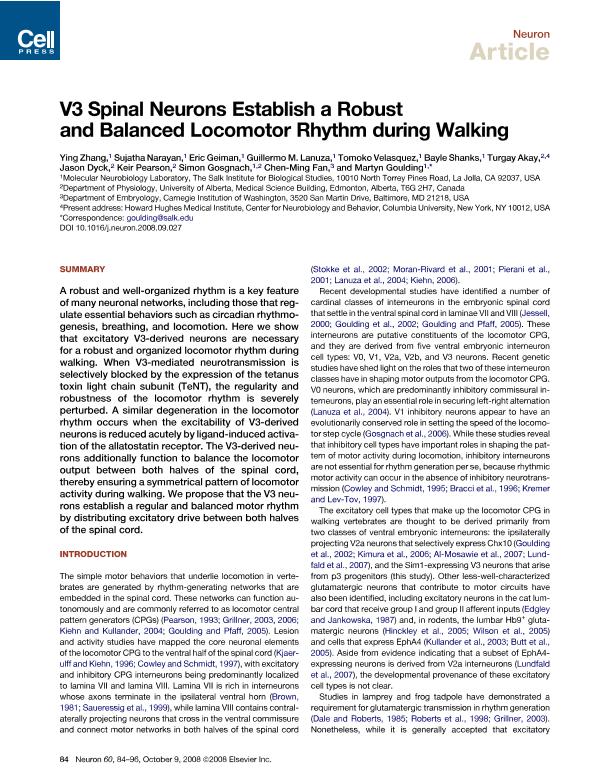Artículo
V3 spinal neurons establish a robust and balanced locomotor rhythm during walking
Zhang, Ying; Narajan, Sujatha; Geiman, Eric; Lanuza, Guillermo Marcos ; Velasquez, Tomoko; Shanks, Bayle; Akay, Turgay; Dyck, Jason; Pearson, Keir; Gosgnach, Simon; Fan, Chen-Ming; Goulding, Martyn
; Velasquez, Tomoko; Shanks, Bayle; Akay, Turgay; Dyck, Jason; Pearson, Keir; Gosgnach, Simon; Fan, Chen-Ming; Goulding, Martyn
 ; Velasquez, Tomoko; Shanks, Bayle; Akay, Turgay; Dyck, Jason; Pearson, Keir; Gosgnach, Simon; Fan, Chen-Ming; Goulding, Martyn
; Velasquez, Tomoko; Shanks, Bayle; Akay, Turgay; Dyck, Jason; Pearson, Keir; Gosgnach, Simon; Fan, Chen-Ming; Goulding, Martyn
Fecha de publicación:
10/2008
Editorial:
Cell Press
Revista:
Neuron
ISSN:
0896-6273
e-ISSN:
1097-4199
Idioma:
Inglés
Tipo de recurso:
Artículo publicado
Clasificación temática:
Resumen
A robust and well-organized rhythm is a key feature of many neuronal networks, including those that regulate essential behaviors such as circadian rhythmogenesis, breathing, and locomotion. Here we show that excitatory V3-derived neurons are necessary for a robust and organized locomotor rhythm during walking. When V3-mediated neurotransmission is selectively blocked by the expression of the tetanus toxin light chain subunit (TeNT), the regularity and robustness of the locomotor rhythm is severely perturbed. A similar degeneration in the locomotor rhythm occurs when the excitability of V3-derived neurons is reduced acutely by ligand-induced activation of the allatostatin receptor. The V3-derived neurons additionally function to balance the locomotor output between both halves of the spinal cord, thereby ensuring a symmetrical pattern of locomotor activity during walking. We propose that the V3 neurons establish a regular and balanced motor rhythm by distributing excitatory drive between both halves of the spinal cord.
Palabras clave:
Interneuron
,
Locomotion
,
Cpg
,
Spinal Cord
Archivos asociados
Licencia
Identificadores
Colecciones
Articulos(IIBBA)
Articulos de INST.DE INVEST.BIOQUIMICAS DE BS.AS(I)
Articulos de INST.DE INVEST.BIOQUIMICAS DE BS.AS(I)
Citación
Zhang, Ying; Narajan, Sujatha; Geiman, Eric; Lanuza, Guillermo Marcos; Velasquez, Tomoko; et al.; V3 spinal neurons establish a robust and balanced locomotor rhythm during walking; Cell Press; Neuron; 60; 1; 10-2008; 84-96
Compartir
Altmétricas



